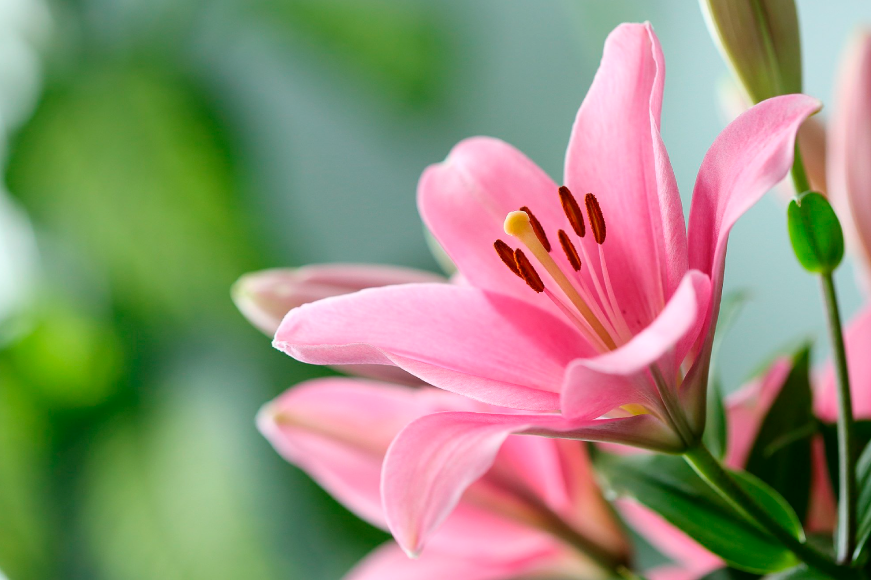
Lilies (gaulish "li-li", that is, "white") are beautiful delicate flowers that will adorn any garden and fill it with an incomparable summer fragrance.
Lilies are a bulbous perennial plant. Flowers form large inflorescences, which have from 8 to 16 flowers, and sometimes even up to 30. Flowers bloom alternately, starting from the bottom. The flowering time of each of them is about a week.
Modern hybrid varieties differ from the classic white lily in many characteristics, such as flower shape, texture, color and coloration.
It's important to know.
Landing. The best period for planting lilies is spring or autumn. You need to plant in areas protected from the wind so that the wind does not break them. The soil should be well-drained, aerated and light, with a small amount of organic additives, peat, humus. You can also enrich the soil with wood ash and superphosphate, which will add minerals to the bulb. To ensure looseness, it is worth mixing the soil with sand. You cannot apply fresh manure during planting in the spring, it is better to do this in the fall.
The distance between each hole should be at least 20 cm, depending on the variety, the depth should be 5-10 cm. In the southern and eastern regions, you do not need to dig out the bulbs, and if you live in the western regions, it is better to plant in special baskets that make it easier digging process.
Care. Lily care includes watering, feeding, loosening the soil after each watering and cleaning weeds. Lily bulbs must be protected from overheating and drying out. To avoid this, it is recommended to plant other decorative flowers in an open field garden where lilies grow so that the lower part of them remains in the shade, and the upper part in the sun.
Reproduction. Lilies are bred mainly by dividing the bulbs. The only condition for their use is a limited amount of starting material and a desire to preserve the characteristics of the most valuable or rare varieties. Of course, the transplant is not recommended during flowering, as this will negatively affect the maturation of the planting material.
Watering. In the garden, lilies need to be watered regularly and abundantly, but do not allow moisture to stagnate in the root zone. If shading plants grow on the flower bed, preventing the evaporation of moisture from the soil, it is recommended to reduce the amount of watering. Before flowering, these plants are watered often, 1-2 times a week, after flowering - 1 time. On hot summer days, lilies need more moisture, so if you notice that the leaves have dropped on the flower, water it and try to prevent it from drying out again.
However, this does not mean that excessive watering is a good solution. Bulbous flowers mainly suffer from waterlogged soil, so they can begin to rot, become covered with powdery mildew or grow poorly.
Fertilizers. To properly care for lilies, they need to be fed 3-4 times during the entire growth period. At the beginning of the growth of the aerial part, a large amount of nitrogen is required. To do this, add organic additives such as chicken manure, rotted cow dung to a humus state. You can also use humate. During the formation of buds, the flowers will need potassium and phosphorus. They can be applied separately at 15 g per 1 m², or it is better to use ready-made complex preparations. If you don't dig up the bulbs, you also need to take care of the plants in the fall, applying both organic and mineral fertilizers. Remember that maintaining the proportions of fertilizers is important, as too much fertilizer can lead to diseases of your plants.
Diseases. We talked about some types of diseases of bulbous plants and their causes (drying out, excessive watering, excess fertilizers), but there are also those, as a prevention of which lilies can be sprayed with weak solutions of fungicides and sprinkle the surface of the soil with wood ash, which acts as an excellent antiseptic and scares insect pests. It is worth noting that mulching the beds with mown grass or peat will also help to avoid drying out.
Storage of bulbs. In the fall, before frost approaches, you can start digging out the bulbs. Until this moment, they cannot be watered for 1-2 weeks, and if it rains, let it dry in the soil. Clean the dug out bulbs from the soil, being careful not to damage the roots, dry them for several days in the fresh air. Then put them in special baskets for bulbs or boxes, sprinkle with dry sand, straw or sawdust. The boxes should be stored in a cool dry place.
Important information: do not plant lilies at home. They can cause headaches.
We hope our tips will help you ennoble your garden and enjoy it’s fragrance.
“Domino” wishes you all the best!
